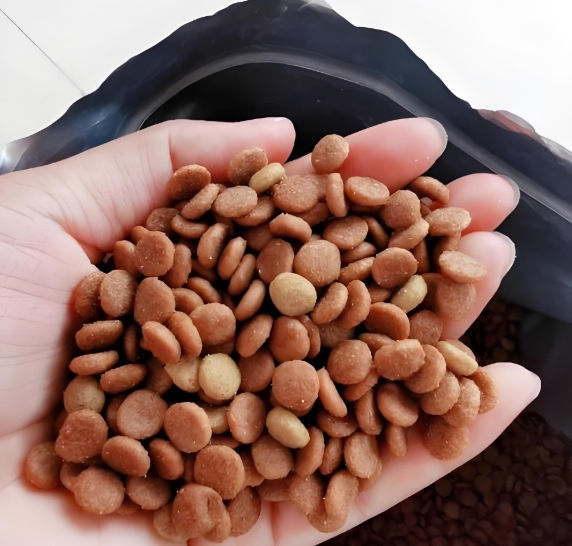Cómo se fabrica el alimento seco para perros: Del ingrediente crudo a la croqueta
Dry dog food, commonly known as kibble, is the most popular form of dog nutrition due to its convenience, long shelf life, and affordability. But have you ever wondered how those uniform, bite-sized pieces are actually made? The process is a fascinating blend of food science, engineering, and nutrition.
The primary method for producing kibble is called extrusión. Here’s a step-by-step breakdown of this complex industrial process.
Step 1: Formulation and Receiving Raw Materials
It all starts with a recipe created by pet nutritionists. This formula ensures the final product is “complete and balanced,” meeting specific nutritional standards like those set by AAFCO (Association of American Feed Control Officials).
- Ingredientes typically include:
- Fuentes de proteínas: Meat meals (e.g., chicken meal, fish meal), which are concentrated, dried proteins. Fresh meats can also be used but require immediate processing.
- Hidratos de carbono: Grains like corn, wheat, or rice; or grain-free options like potatoes, peas, or lentils.
- Grasas y aceites: Animal fats, vegetable oils, and omega fatty acid blends.
- Vitamins and Minerals: Pre-mixed blends added to ensure nutritional completeness.
- Fibre: Sources like beet pulp, powdered cellulose, or rice bran.
All incoming ingredients are rigorously inspected and tested for quality and safety.
Step 2: Grinding and Mixing
The raw ingredients are first ground into a fine powder using a hammer mill. This creates a uniform consistency, which is crucial for the next steps and ensures every piece of kibble has the same nutritional profile.
The ground ingredients are then precisely weighed according to the recipe and blended together in a large mixer. This creates a uniform dry mixture called “meal.”
Step 3: Pre-Conditioning
The dry meal is fed into a large, preconditioning chamber where it is mixed with hot water, steam, and sometimes liquid fats. This creates a moist, dough-like mixture with the consistency of thick paste.
- Propósito: Pre-conditioning hydrates the starches, begins the cooking process, and makes the dough pliable enough for the next critical step—extrusion.
Step 4: Extrusion – The Heart of the Process
The hot, moist dough is forced through a machine called an extrusora. It works like a giant meat grinder or pasta-maker.
- The dough is pushed through a barrel by a large screw under intense heat and pressure.
- At the end of the barrel, the dough is forced through a metal plate called a morir. The shape of the holes in the die determines the shape of the kibble (e.g., bones, stars, circles).
- As the pressurized dough exits the die into the open air, it instantly “puffs” or expands. This is due to the sudden drop in pressure, which causes the superheated water in the dough to flash into steam. This expansion is what gives kibble its airy, crunchy texture.
Step 5: Drying
The expanded, soft kibble pieces are very moist and must be dried to become stable. They are conveyed through a large, multi-level oven called a dryer.
- Hot air is blown over the kibble to remove most of the moisture.
- Reducing the moisture content to around 10% is essential for preserving the food and preventing mold and bacterial growth.
Step 6: Coating (Enrobing)
After drying, the kibble is tumbled in a large drum, often called a fat applicator.
- Liquid, digestible fats, oils, and vitamin palatants are sprayed onto the kibble as a fine mist.
- Propósito: This coating significantly enhances the food’s flavour (palatability), makes it more appealing to dogs, and adds essential fatty acids that can be damaged by the high heat of the extrusion and drying processes.
Step 7: Cooling and Packaging
The freshly coated kibble is still warm and must be cooled to a safe temperature for packaging. It is moved through a refrigerador where ambient air is blown over it.
- Once cooled, the kibble is transported via conveyor belts to automated scales and bagging machines.
- It is packaged into bags, which are often flushed with nitrogen or carbon dioxide to replace oxygen. This “modified atmosphere packaging” helps prevent fat spoilage (rancidity) during storage and transport.
Step 8: Quality Control
Throughout the entire process, stringent quality control checks are performed. Samples are taken at various stages and tested for:
- Nutritional accuracy
- Bacterial contamination
- Contenido en humedad
- Kibble size, shape, and density
Conclusion: A Precise Science
The creation of dry dog food is not a simple baking process; it’s a highly sophisticated feat of food engineering designed to create a nutritious, shelf-stable, and consistent product. While the quality of ingredients can vary dramatically between economy and premium brands, the fundamental extrusion process remains the same, turning a diverse mix of raw materials into the iconic kibble that fuels our canine companions.








